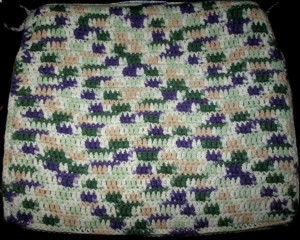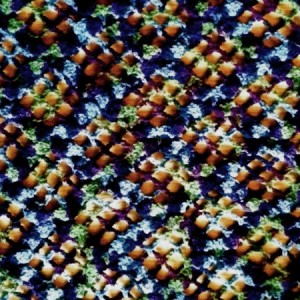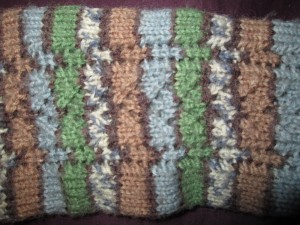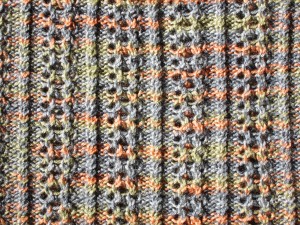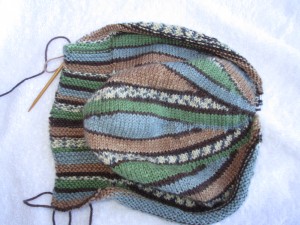The ultimate goal of this series on variegated yarn is to provide helpful information when deciding how to pair variegated yarn with a pattern.
In general, it is best to use variegated yarn with projects that make use of simpler stitches – you can use busy yarn or busy stitch work, but you shouldn’t use both. In addition to this guideline, you should take into account the type of variegated yarn (i.e. short patterning, long patterning, self striping, etc., as discussed in the last post) and the shaping (or lack thereof) in the pattern. A pattern with little or no shaping (such as increases and decreases) will result in regular color patterning just like the swatches in the previous posts. A pattern with lots of shaping will result in a more random assortment of color patterning.
The following examples show cases where I believe I have successfully coupled variegated yarn and a pattern.
This seat cushion uses short patterning variegated yarn and no shaping. This project is crocheted back and forth in rows, with one row of double crochet followed by a row of single crochet. Because the double crochet rows are wider, their colors stand out, and a diagonal striped pattern is visible (instead of the zigzag pattern normally expected when working back and forth in rows).
The next example shows a portion of a baby blanket made with short patterning variegated yarn. The blanket itself is square, so there is no shaping. However, each row uses a different amount of closed and open work than the adjacent rows, so the colors form a more random pattern instead of the usual zigzag expected of this yarn.
These socks are made with self-striping yarn. A little openwork patterning is done on the sides.
Short patterning yarn is used for this vest, which is knitted back and forth in rows. A simple lacy pattern and some shaping combine to allow the colors a bit of freedom in their patterning. (By the way, the knitting pattern for this vest is available in my etsy store.)
In the last example, self-striping yarn is used in a pattern that requires a lot of shaping. I’m developing the beret seen below as a way to use self-striping yarn to get more than just stripes.
These are just some of the ways that I have used variegated yarn. Over the years I have made many mistakes when forcing a yarn I love to go with a pattern I love even if the two don’t go together. Spending time thinking about how the colors will play out (using the basic principle presented in the previous posts) and, yes, making swatches are important steps in determining if you have the right yarn for the project – or the right project for the yarn.
What are your success stories in using variegated yarn? I’d love to see and hear about your variegated yarn projects!

